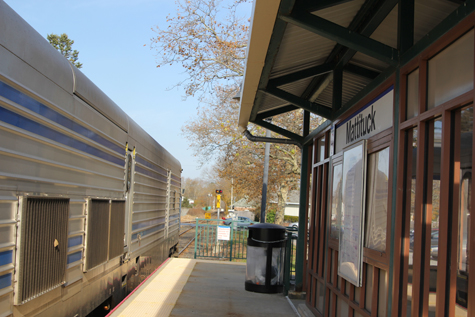Column: Fanfare for the common commuter

He sat in the middle of the bus, at a window, looking out.
Middle-aged, dressed in a suit, white shirt and tie, he was always there whenever I boarded the dawn bus in Greenport that took us to Ronkonkoma, where we changed for the Manhattan train.
In those days, I was living in East Marion and made the trip once every six weeks or so, always amazed that a ride of about 90 miles took three hours. It was like being a character in a 19th-century Russian novel on a long, uncomfortable voyage from the provinces up to the capital.
The man in the middle of the bus was certainly a character. He was always there. He never had anything to read, no newspaper or book, no earbuds, nothing except himself in his crisp suit, looking out the window.
Some people would greet him and he was always courteous, but his exaggerated politeness was a way of shutting off conversation rather than inviting it.
One morning I sat down next to him and started a conversation. He lived in Orient and worked for an engineering firm in the city.
“Some commute,” I said.
He nodded.
“You do this every day?”
“Well, no,” he said, “Just five days a week.”
There was no pleasant way of asking the next question, so I was blunt. “Why?”
“Why?” It was as if the thought had never occurred to him.
“Six hours a day commuting?” I said.
“Well,” he replied, still with an air of curiosity that anyone would wonder about his reasons. “I really enjoy my job and I love where I live.”
But you’re never home to love it, you damned fool, I wanted to say, but was respectful, and anyway, he’d already turned away and was looking out the window.
He was either a madman or some kind of savant, I thought, a person I could never begin to understand.
I thought of him as the recent deadline approached on union contracts with the Long Island Rail Road, and the possibility of an unholy mess if the trains shut down. I also thought of my commute, about six to eight minutes from Silver Beach to the Center.
The man from Orient and his ilk are known to the U.S. Census Bureau as “extreme” commuters, or those who take more than 90 minutes out of their day to get from home to work and back home. He’d be similar to contemporary Beijing workers who hold the current world record by traveling on average about three hours daily, according to a study by Peking University.
The Census Bureau also found that Long Islanders — along with residents of the rest of the New York Metro area — have the longest commute by car in the country, averaging about 36 minutes each way.
Idling next in line are residents of the Washington, D.C., suburbs, where it takes about 34 minutes, followed by those in the Poughkeepsie-Newburgh-Middletown, N.Y., area, clocking in at 32 minutes.
Shortest commute? Except for mine? It’s a breezy 14 minutes to get to work for the lucky folks living in greater Grand Forks, North Dakota. But the downside is … well, you know.
All that commuting is unhealthy, according to a study published by researchers at the Washington University School of Medicine in St. Louis. The study found that those who commute by car 10 miles or farther each way are at risk of serious high blood pressure complications.
That seems right, since we all know cursing the driving habits of fellow worker bees buzzing toward their respective hives, although providing a fleeting cathartic high, can’t be beneficial. (George Carlin explained the drill: Everyone driving slower than you is a moron; everyone driving faster than you is a maniac.)
Carpooling is an answer to commuting hell by saving you stress and money, as well as the Earth. But there are other people who, when forced to be in a car with someone else behind the wheel (moron, maniac), go to pieces in a hurry.
Carpooling has not really caught on. The New York State Department of Transportation says that of the 1.1 million Long Islanders who drive to work, 86 percent, or 950,000, go solo.
The Census Bureau has reported that the number of people carpooling nationally is in steep decline, dropping by half since the 1980s. This baffles some social scientists who point to the availability of social media to communicate and hook up, which seemingly should increase ride sharing. But only about 12 percent of commuters carpool.
Some explanations for the numbers of those going it alone are increased car ownership and unemployment rates. But North County Times, a newspaper serving the San Diego area, quoted Robert Poole, a transportation expert with a Los Angeles think tank, that the “recession is a short-term phenomenon, but the carpool decline is a longer-term trend.”
Mr. Poole thinks personal freedom is at play, with commuters happy doing things by themselves before and/or after work.
It’s been an idea of mine that, contrary to what most people say, they actually enjoy their solo commutes. It’s a time of transition, going from one people-saturated routine to another. No husband, wife, kids, relatives, friends, colleagues. Just solitude.
I thought of my man on the bus. Maybe he wasn’t crazy.
Maybe silently watching the world go by with his own thoughts was keeping him sane.
Ambrose Clancy is the editor of The Shelter Island Reporter, owned by Times/Review Newsgroup. He can be reached at [email protected].








